Explore the profound stories of interracial couples in the Bible, revealing timeless lessons on love, diversity, and acceptance.
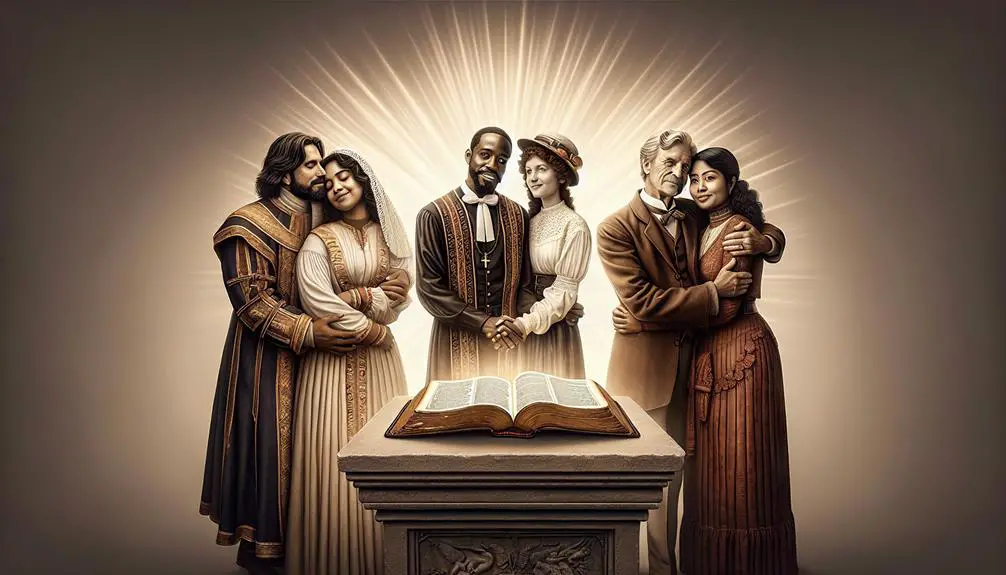
Interracial Couples in the Bible
Consider Moses and Zipporah, a prime example of an interracial couple in the Bible. Their union, crossing cultural and ethnic boundaries, highlights the complexity and richness of relationships in ancient times.
You might wonder how their story, along with others like Ruth and Boaz or Joseph and Asenath, influences our understanding of diversity and acceptance in sacred texts. These narratives aren't just ancient history; they offer insights into the challenges and triumphs of love across different cultures.
By exploring these relationships, you'll uncover layers of meaning about faith, identity, and the universal quest for connection.
Key Takeaways
- Interracial couples in the Bible showcase cultural integration, diplomacy, and unity amid diversity.
- These narratives challenge contemporary views on identity, encouraging tolerance and mutual respect across cultures.
- Stories of betrayal and trust issues within interracial relationships reveal complex dynamics and the importance of loyalty.
- Interracial unions often highlight ethical dilemmas and tragic consequences, reflecting on the broader societal impacts of personal actions.
Moses and Zipporah: A Union Across Cultures
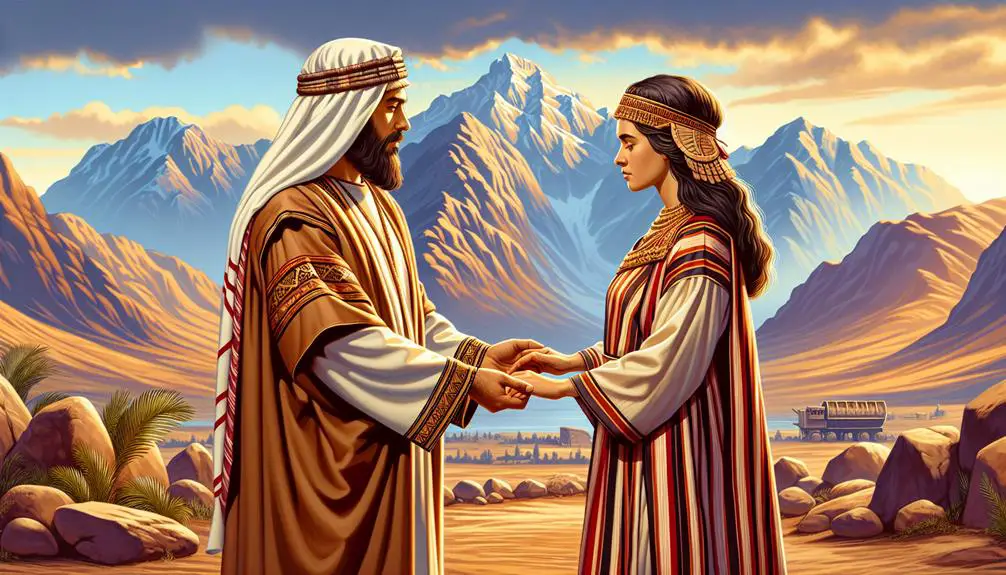
Among the notable examples of interracial couples in the Bible, the union of Moses and Zipporah stands out, illustrating a profound intersection of cultures and faiths. This marriage not only signifies personal commitment but also embodies the complexities and potential for cultural adaptation inherent in such unions. Moses, an Israelite, finds love and companionship in Zipporah, a Midianite, navigating the intricacies of blending two distinct cultural backgrounds. This relationship serves as a pivotal example of overcoming barriers through mutual respect and adaptation.
The religious implications of Moses and Zipporah's marriage are equally significant. It underscores the broader theme of inclusivity and acceptance within the biblical narrative. Their union challenges and expands the contemporary understanding of religious and cultural identity, suggesting that faith and love can transcend traditional boundaries. Furthermore, Zipporah's intervention in a critical religious rite (the circumcision of their son) highlights her role in not just bridging two cultures but also in ensuring the continuity of Moses' religious obligations. This act symbolizes the interweaving of their respective beliefs and practices, showcasing the depth of their partnership.
Joseph and Asenath: Bridging Nations
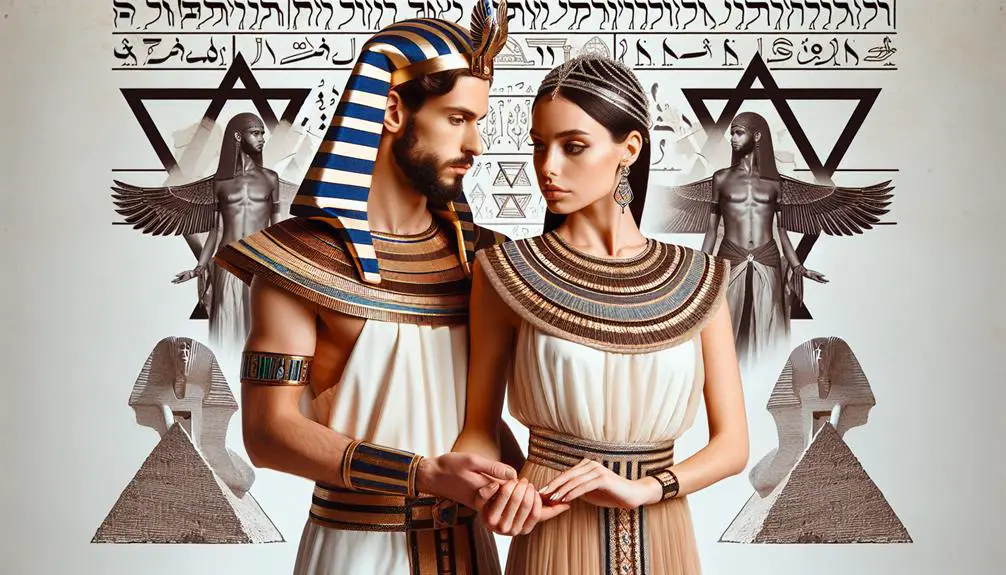
Another illustrative example of interracial marriage within the biblical narrative is the union between Joseph, a Hebrew, and Asenath, an Egyptian, which serves as a testament to the bridging of nations through personal relationships. This marriage encapsulates not only the blending of personal lives but also signifies the potential for cultural adaptations and the navigation of religious implications inherent in such unions.
You find that Joseph, elevated to a position of power in Egypt, marries Asenath, the daughter of an Egyptian priest. This union underscores a significant cultural integration, as Joseph, despite his Hebrew background, becomes assimilated into Egyptian society, holding a prominent governmental position. The marriage to Asenath, therefore, isn't just a personal alliance but also a symbol of Joseph's acceptance and adaptation to Egyptian culture.
However, the religious implications of their marriage are profound. While the biblical text doesn't delve deeply into the intricacies of their religious reconciliations, Joseph's steadfast maintenance of his Hebrew faith, juxtaposed with Asenath's background in a polytheistic society, suggests a complex interweaving of religious identities and practices within their household. This narrative invites you to ponder the challenges and opportunities that such interfaith marriages present, highlighting the broader themes of tolerance, adaptation, and unity across differing cultural and religious landscapes.
Ruth and Boaz: Love Beyond Borders
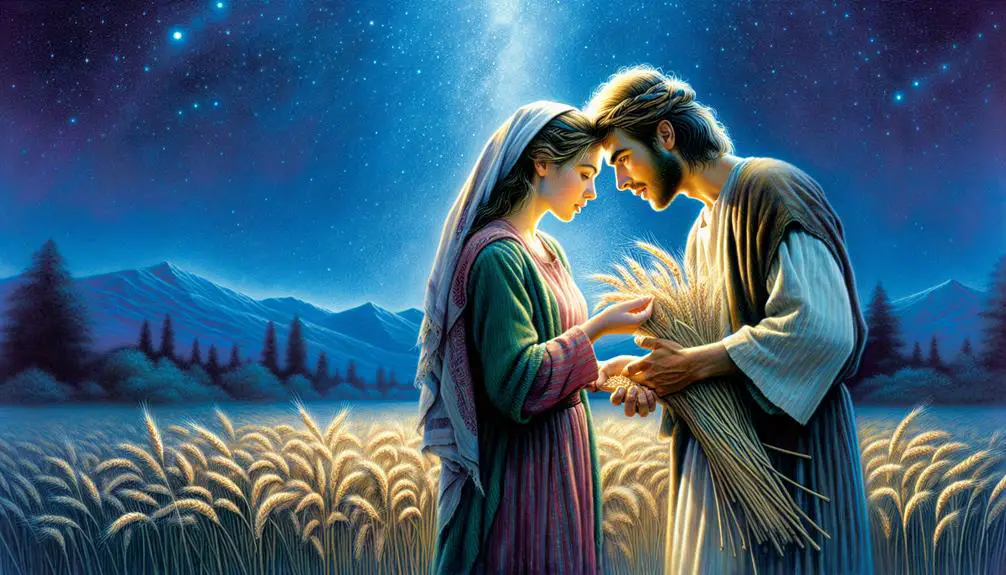
Building on the theme of cross-cultural unions, the story of Ruth and Boaz presents a compelling example of love transcending national and ethnic barriers. This narrative not only enriches our understanding of personal relationships in the biblical context but also offers insights into the broader social implications and possibilities for cultural integration.
- Cultural Integration: Ruth, a Moabite, decides to stay with Naomi, her Israelite mother-in-law, demonstrating a profound commitment not just to an individual but to a whole new community. Her integration into Boaz's life, and by extension, into the Israelite community, symbolizes the potential for cultural fusion and acceptance beyond mere tolerance.
- Social Implications: Their union challenges and redefines the existing social norms of their time. It shows that love and loyalty can bridge the vast divides created by nationality and culture, suggesting a more inclusive understanding of community and belonging.
- Legacy of Inclusivity: The story of Ruth and Boaz doesn't just end with them; it carries forward, impacting the lineage of David and, ultimately, the genealogy of Jesus. This highlights the lasting significance of their interracial and intercultural union, setting a precedent for future generations regarding the value of inclusivity and love without borders.
Through the lens of Ruth and Boaz's relationship, we're offered a timeless lesson on the power of love to transcend cultural and ethnic divisions, encouraging a more integrated and socially inclusive community.
Esther and King Ahasuerus: Uniting Diverse Realms
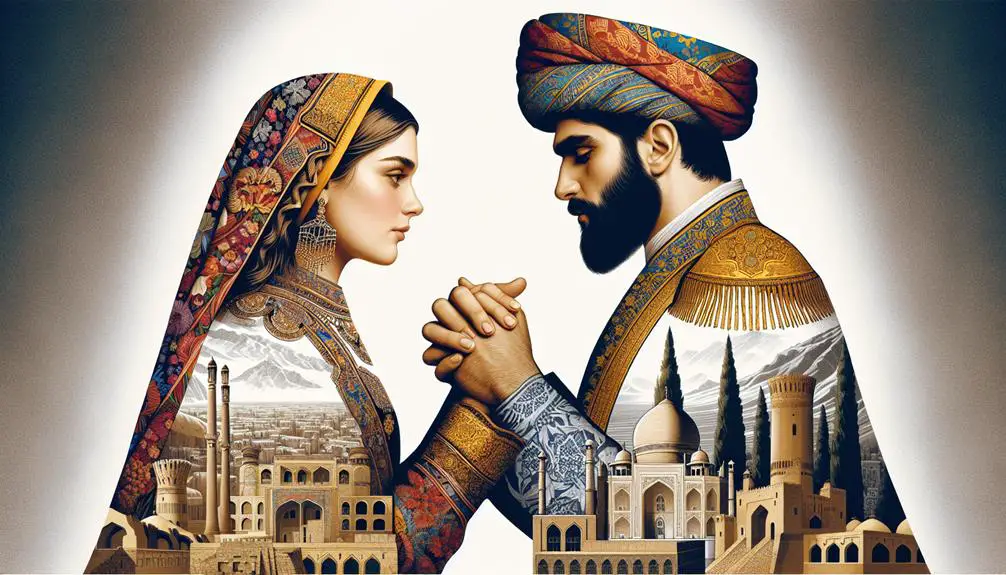
The story of Esther and King Ahasuerus exemplifies how individual relationships can bridge vast cultural and political divides, serving as a catalyst for unity between disparate realms.
You observe this narrative through the lens of cultural diplomacy, where Esther, a Jewish woman, becomes queen to King Ahasuerus of Persia, embodying a powerful example of cross-cultural union. Through her strategic use of influence and understanding of both her own cultural heritage and that of the Persian court, Esther facilitates a pivotal shift in royal decrees, effectively altering the course of her people's history.
This union, marked by its strategic significance, leverages the intimate bonds of marriage to foster broader political and cultural understanding. Esther's story transcends personal triumph, illustrating how royal decrees can be instrumental in promoting tolerance and protecting minority rights within a vast empire. Her adept navigation of court politics and her pivotal role in the issuance of decrees that safeguard her people highlight the potential of individual agency in effecting significant change across realms.
Through Esther and King Ahasuerus's relationship, you witness the power of love and strategic alliances in overcoming prejudice and uniting diverse societies. Their story underlines the importance of cultural diplomacy and the impact of personal relationships on broader socio-political landscapes.
Solomon and the Queen of Sheba: A Royal Exchange
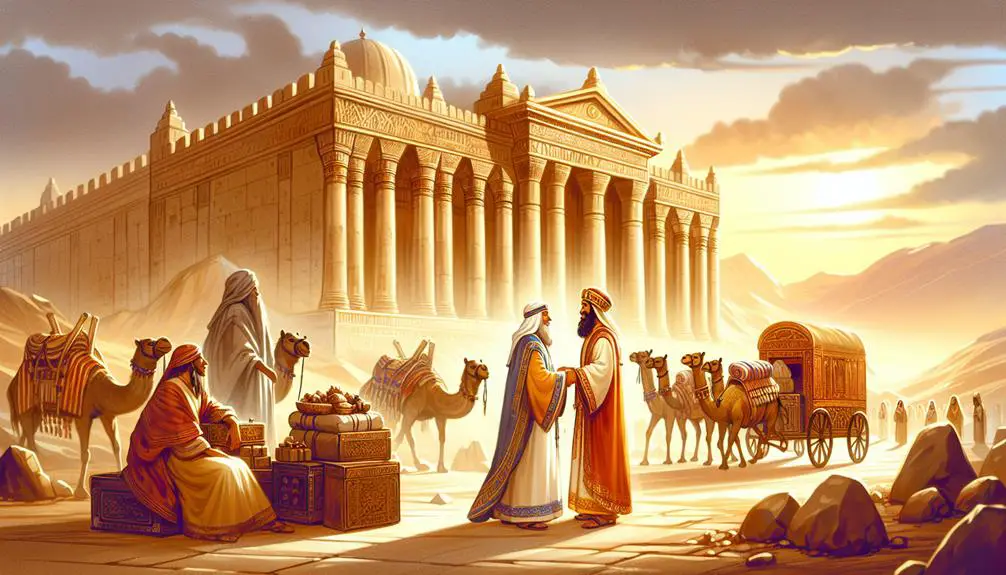
Just as Esther's marriage to King Ahasuerus bridges cultural divides, the encounter between Solomon and the Queen of Sheba represents a significant exchange of wisdom and wealth, highlighting the potential for intercultural dialogue and mutual respect. Their meeting isn't merely a tale of fascination but an exemplar of how two leaders can engage in trade diplomacy and wisdom exchange, fostering understanding and cooperation between their realms.
- Trade Diplomacy: The Queen of Sheba's visit to Solomon with a caravan of riches symbolizes the opening of trade routes and economic exchanges between their nations. This act of diplomacy strengthens their kingdoms economically and politically, setting a precedent for future interactions.
- Wisdom Exchange: Solomon and the Queen of Sheba's discussions go beyond mere pleasantries; they delve into deep philosophical and theological dialogues. This exchange of wisdom not only enriches their personal understanding but also solidifies a bond of mutual respect and admiration between them.
- Cultural Integration: The visit underscores the potential for cultural integration through respectful curiosity and openness. Their willingness to learn from each other fosters a sense of unity and shared identity, transcending geographical and cultural barriers.
This story, then, serves as a powerful testament to the benefits of intercultural exchanges, enriching societies through diversity and understanding.
Samson and Delilah: A Story of Contrasts
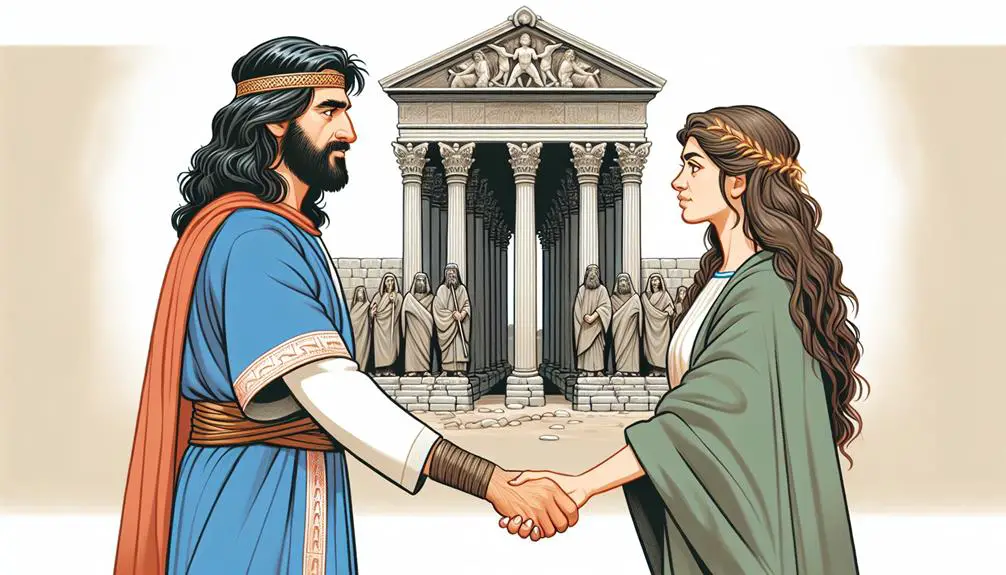
In stark contrast to the harmonious exchange between Solomon and the Queen of Sheba, Samson and Delilah's story unfolds as a narrative of betrayal, highlighting the complexities of interpersonal relationships within diverse cultural contexts. This tale, deeply rooted in power dynamics and trust issues, serves as a critical examination of how differing backgrounds can influence and, at times, complicate interactions between individuals.
You'll find that power dynamics play a central role in Samson and Delilah's relationship. Samson, possessing immense physical strength, is vulnerable to Delilah's emotional and psychological manipulation. This imbalance underscores the fragility of trust and how easily it can be exploited within a partnership, especially when external pressures and motivations come into play.
Trust issues are paramount in this narrative, as Delilah's betrayal of Samson to the Philistines for monetary gain illustrates a profound breach of trust. This act not only reflects personal greed but also emphasizes the cultural and ethnic tensions that can exacerbate conflicts within an interracial relationship.
Analyzing Samson and Delilah's story, you're invited to consider the implications of power dynamics and trust issues not just in historical or biblical contexts but in how they resonate with contemporary discussions on relationships across cultural divides.
Uriah the Hittite and Bathsheba: Complex Ties
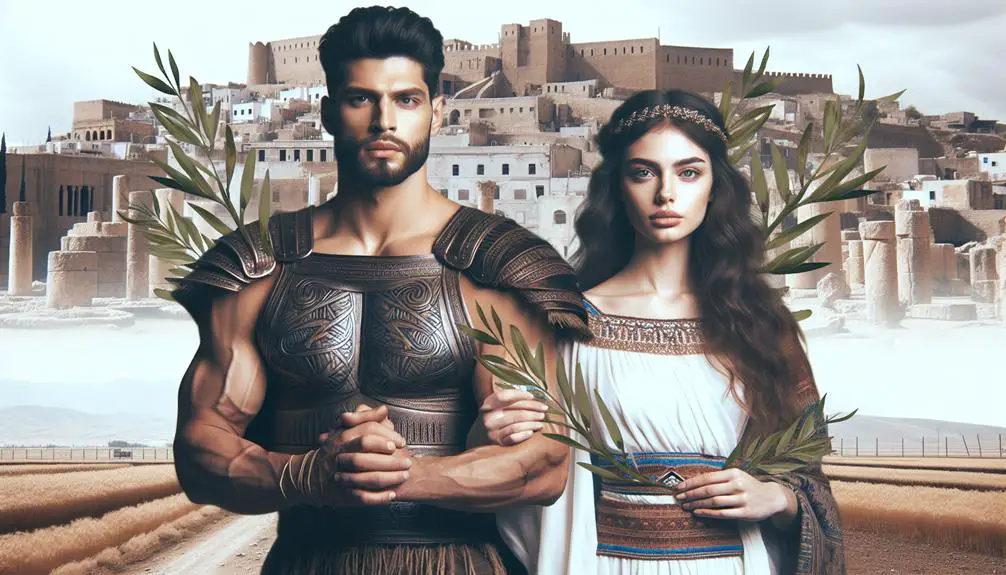
Delving into the complex ties between Uriah the Hittite and Bathsheba, we uncover a narrative fraught with moral and ethical dilemmas that challenge traditional views on loyalty and love. This story, set against the backdrop of Hittite culture and David's guilt, presents a unique intersection of interracial marriage, betrayal, and tragedy in the biblical context.
- Hittite Culture: Uriah, as a Hittite, represents a cultural and ethnic diversity within the Israelite society. His marriage to Bathsheba, an Israelite, reflects the existing interracial unions during this period. However, the respect and loyalty Uriah exhibits, characteristics esteemed in Hittite culture, starkly contrast with King David's actions.
- Betrayal and Tragedy: The narrative takes a dark turn as David, smitten with Bathsheba, orchestrates Uriah's death to cover up his own guilt after impregnating Bathsheba. This act of betrayal not only highlights David's guilt but also the complexities surrounding power, morality, and the consequences of one's actions.
- David's Guilt: The aftermath of Uriah's death and David's union with Bathsheba is marred by David's overwhelming guilt. This guilt serves as a pivotal moment in the biblical narrative, emphasizing themes of repentance, forgiveness, and the complexities of human nature and divine justice.
In analyzing Uriah and Bathsheba's story, we gain insights into the deeply intertwined themes of love, loyalty, and cultural intersectionality within the biblical narrative.
Frequently Asked Questions
How Have Interpretations of These Interracial Couples in the Bible Changed Over Time in Various Religious Communities?
You're examining how cultural interpretations and historical accuracy have shifted perspectives on specific narratives over time within diverse religious communities.
Initially, you'll notice a range of interpretations, reflecting varying emphasis on textual analysis and the influence of contemporary social attitudes.
Over the years, scholars and believers alike have revisited these stories, leading to a more nuanced understanding that often challenges or broadens earlier views, reflecting evolving societal norms and academic insights.
What Are the Psychological Impacts on Individuals and Communities When Biblical Stories of Interracial Couples Are Either Emphasized or Ignored in Religious Teachings?
When religious teachings emphasize or ignore certain narratives, it impacts individuals' and communities' psychological well-being.
You'll find that focusing on diverse narratives can foster inclusivity, enhancing mental health.
Conversely, ignoring these stories may lead to feelings of exclusion or inferiority among members.
Counseling approaches and mental health initiatives that incorporate an understanding of these dynamics can more effectively address the psychological needs of diverse religious communities, promoting a healthier, more inclusive environment.
How Do Modern Archaeological Findings Support or Contradict the Historical Existence of These Biblical Interracial Relationships?
You're diving into how archaeological discoveries confirm or challenge the reality of historical relationships. Artifact authenticity plays a crucial role in this analysis, as it helps to verify the timelines and cultural contexts of these narratives.
Moreover, cultural symbolism found in these artifacts can offer insights into societal attitudes towards these unions at the time. It's a complex interplay of evidence and interpretation that shapes our understanding of past social dynamics.
In What Ways Have These Biblical Stories of Interracial Couples Been Used in Contemporary Debates About Race Relations and Multiculturalism?
As you delve into contemporary debates, remember 'old wine in new bottles.' Stories from the past, rich in cultural symbolism, are often repurposed to navigate today's discussions on race relations and multiculturalism. They serve not just as historical curiosities but as powerful tools in understanding and challenging the legal implications and societal norms of our time.
Analyzing these narratives offers insights into how societies evolve and adapt their views on race and culture.
What Role Do Gender Dynamics Play in the Narratives of These Interracial Couples, and How Might These Dynamics Offer Insights Into Ancient Societal Views on Gender and Race?
When examining narratives about couples from different backgrounds, you'll find that marriage rituals and authority figures play a crucial role. These elements not only reflect the gender dynamics of the time but also offer insights into ancient societal views on gender and race.
Conclusion
In conclusion, the tapestry of interracial couples in the Bible showcases the complex interweaving of cultures, much like threads of different colors forming a single, vibrant garment.
These narratives, from Moses and Zipporah to Solomon and the Queen of Sheba, not only transcend geographical and ethnic boundaries but also enrich the biblical story with their diverse hues.
Analyzing these unions offers insights into how love, faith, and power navigated the intricate social fabrics of their times, reflecting a universal theme of unity amidst diversity.


Sign up